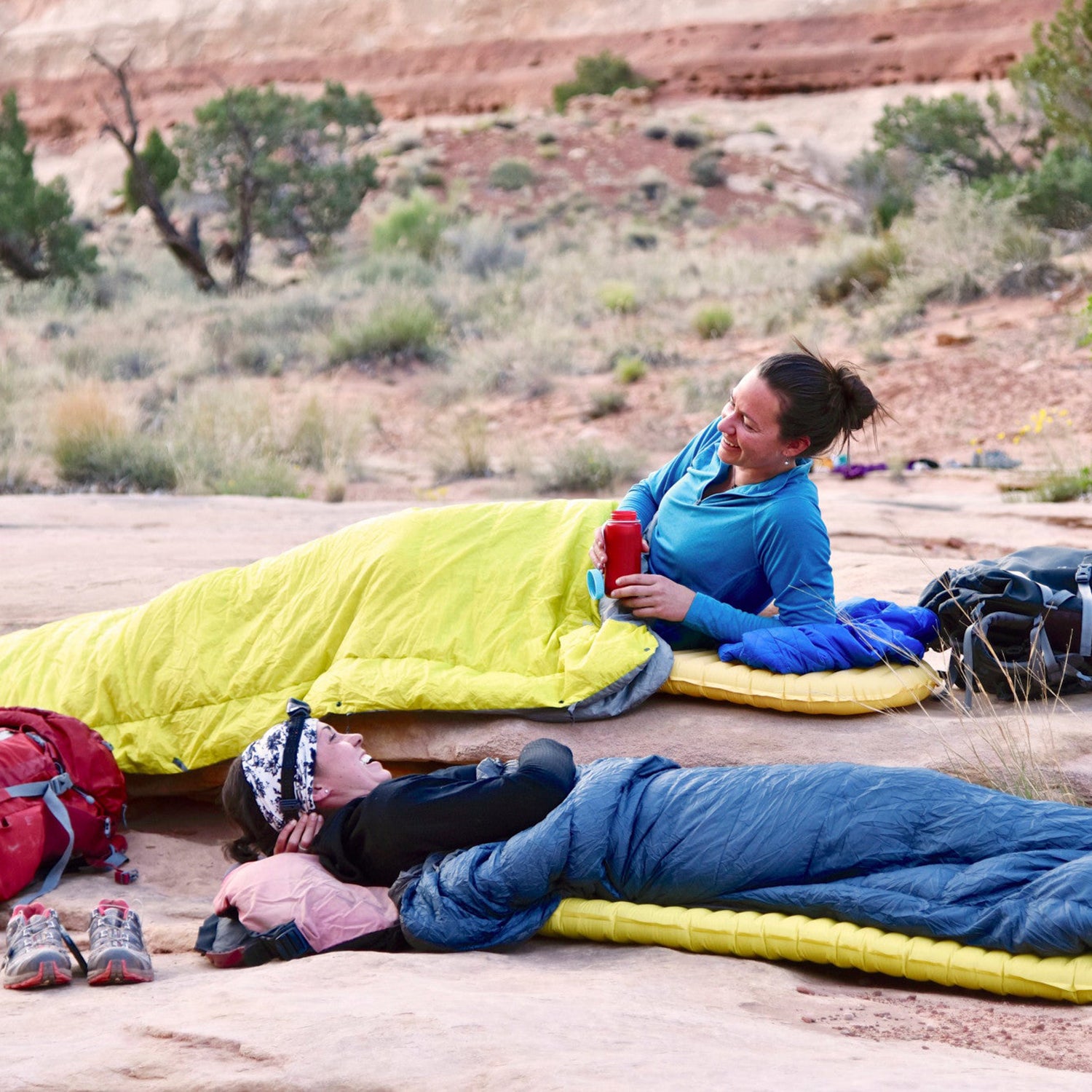If you’ve ever forgotten an important piece of gear on a hike, you probably remember when it hit you—the moment that you went from blithely rummaging in your pack, to seriously digging through it, to finally tearing it apart in search of your puffy, sleeping bag, or stove. Then, when the rest of your gear lay scattered over the ground, a moment of resignation, and a question: What now?
Forgetting a key piece of equipment can (and sometimes should) put an end to your hiking plans. But as with a lot of things in the backcountry, you can often substitute a little bit of know-how for gear, at least for a night or two. We polled the staff about their hard-won solutions for making do without tent poles, bags, hiking shoes, and more—and for their advice about when it’s time to just call it.
Tent Poles
So you packed your tent poles separately from your body and fly, but forgot to add them to your pack? You’re not alone: Just ask Alisha McDarris, and a spare pole from a friend’s tent after she forgot hers on a trip to Big Bend National Park. As her story demonstrates, it’s possible to come up with a makeshift solution when you leave your shelter’s bones at home. What that is depends on where you are, and what you have on you.
The simplest plan B: Do without a tent. People have been cowboy camping since the dawn of the human species, and as long as the weather is calm, the bugs are marginal, and your sleeping bag is warm enough, it’s still a good solution. (Pro tip: If you’re camping on the snow or on wet ground, use your flattened tent’s body as a tarp to keep you from dampening your bag if you roll off your pad.)
If rain is a possibility or the mosquitoes are vicious, all’s not lost. Your best bet is to string up your tent with a bit of cordage (paracord is your best bet, but this trick is possible to pull off with your shelter’s unknotted guylines, or extra rope you didn’t use for your bear hang). The process is easiest with an A-frame tent: Stake out the corners, run a line directly over the top of the tent between two trees or other tie-out points, and attach it with the clips or the pole sleeve. Two lines arranged in an X-shape can help keep your dome tent aloft, though the pitch will be noticeably flappier.
Turn around if: you don’t have the supplies to string up your tent or the weather forecast is truly stormy.
Sleeping Bag
Like your tent poles, you likely won’t realize your sleeping bag is missing until you get to your intended campsite, leaving you with relatively few options to replace it. One easy one is to share with a friend: Unzip their bag and sleep together under it like a quilt. Because your body weight normally compresses the insulation beneath you in your bag, you won’t lose much heat by sleeping directly on top of your pad, though you’ll have to get cozy and stay still to avoid drafts. (Wear a beanie or pull up your jacket’s hood to keep your head warm.)
Going solo? If you brought a , you can make that work in a pinch. Despite how thin they are, they will help keep you warm–I’ve slept through late-spring snowfall under one–but they come with some big caveats. The biggest: They don’t breathe, at all, so be prepared to wake up damp.
Turn around if: you don’t have a partner or an emergency blanket, or the weather is cold enough to risk hypothermia.
Sleeping Pad
Your sleeping pad is a small piece of gear with a big role: That inch or two of foam and air doesn’t just keep you comfy, it helps keep you warm by insulating you from the ground, too. Unfortunately, while improvised solutions can help with the latter, they won’t help much with the former: Get ready for an uncomfortable night.
First of all, consider whether you can get by without a mat—on warm summer nights, it’s possible, though you’ll want to take extra care to find a smooth campsite or else wake up with the indentation of every pebble underneath your tent floor pushed into your back. If temperatures are marginal, you can try emptying out your partner and your backpacks and using them as an improvised pad. (This trick works best with packs that have an internal framesheet; frameless packs won’t be much help.) Backpacking solo? Lay your own empty pack on the ground and practice sleeping sitting up.
Turn around if: there’s snow on the ground or the temperatures are .
Hiking Shoes
Unlike your tent or sleep system, you’ll invariably realize you’ve forgotten your hiking shoes or boots the moment you go to put them on at the trailhead. There’s no hack or trick to replace these: All that’s left is to decide whether the street shoes you’re already wearing can carry you through your planned hike.
First, look at the weather. Sneakers won’t cut it for a winter backpacking trip when there’s snow on the ground. Pay attention to the trail conditions as well: If you’ll be tramping through puddles and getting wet, you’ll need shoes that are either waterproof or dry quickly. Second, look at the terrain. On a packed, even trail, you might be able to get away with wearing your sneakers; if the path is loose, rough, slick, or travels above steep terrain where a fall would be dangerous, it might be unwise to attempt it without better tread. Finally, take a look at your shoes themselves. Are they sturdy enough to handle a day (or days) on the trail without falling apart, and do they have the support you need to tote your pack without twisting an ankle? Use caution with slip-on boots or hiking sandals. Flip-flops and anything else backless is a hard no.
Turn around if: your shoes would put you at risk of injury, frostbite, or unmanageable blisters.
Water Filter
If you left your filter or purifier at home, you still have a safe, old-school solution available to you: Boil your water. Simply add your dirty water to a pot (consider pre-filtering through a bandana or baselayer to get rid of floaters) and bring the water to a rolling boil for one minute, or three minutes at an elevation above 6,500 feet. Let it cool, and pour into your bottle or hydration reservoir. (Some strong-stomached folk may choose to just drink the water straight from the stream, but as some of our colleagues will attest, , you’ll do almost anything to avoid getting it again.)
Turn around if: you don’t have a stove, enough fuel, or access to a water source that you trust enough to drink straight.
Stove
Forgot your stove at home? No you didn’t. You just got a surprise promotion to the ranks of burner-ditching, weight-cutting, cold-soaking lightweight hikers.
Granted, you can’t cold-soak every meal. If you were planning on first-night hamburgers or a pancake breakfast, you’re out of luck. But given enough time, it’s possible to prepare basically any dehydrated backpacking meal without a stove. All you need is time—a lot of it. As Chris Meehan wrote in , most prepackaged backpacking meals take between 30 and 90 minutes to reconstitute, though some (think instant mashed potatoes) are ready much faster. Pour in your water, seal up your bag, and either leave it sitting somewhere stable or carefully tuck it into an exterior pocket of your backpack, and have a taste every 10 minutes or so until it’s softened but not squishy. Delicate taste buds? You may need to hold your nose: Not everything tastes good cold (mmm, room-temperature chili).
Turn around if: you didn’t pack dehydrated vittles.
Headlamp
Headlamps take up very little space and weigh almost nothing, so bringing one is an easy choice. On the other hand, that also makes them easy to accidentally leave behind. Your first thought is likely to use your phone as a flashlight, but we don’t recommend that. While it may be bright enough for close-up tasks, it won’t throw enough illumination to comfortably hike with, and it will drain your battery too. Instead, shift your schedule to take advantage of the ultimate camping lantern: the sun. By getting up and moving at daybreak and aiming to be done with dinner and on your way to bed by dusk, you’ll see more and get better beauty sleep to boot.
Turn around if: you’re hiking during winter’s short days or will be camping or hiking near hazards like fast-flowing rivers or precipitous drops.


